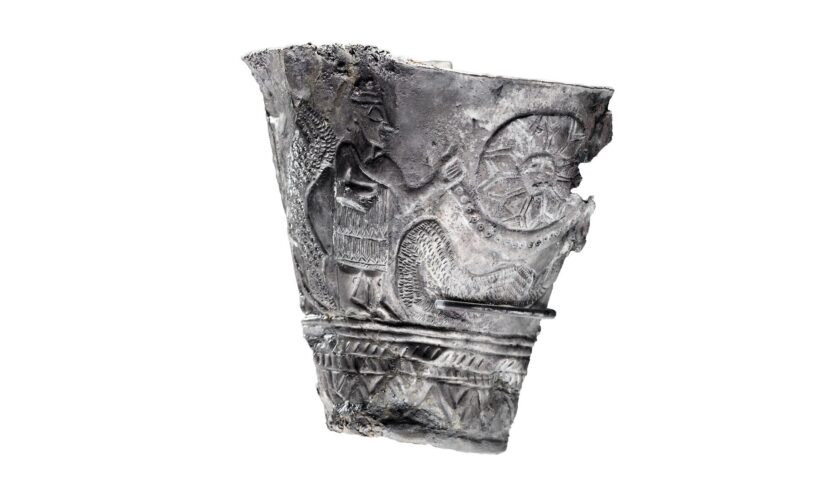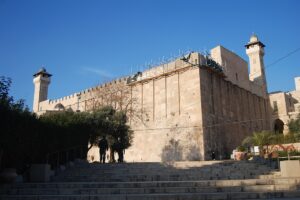
A 4,300-year-old silver goblet featuring the earliest depiction of the Creation narrative from the Near East tradition echoes the struggle between chaos and order from the book of Genesis, a new study published on Thursday suggests.
Departing from the biblical stories, however, it also depicts the celestial image of a mysterious “boat of light.”
The artifact, known as the Ain Samiya goblet, presents two separate scenes. On one side, a human torso holding palm leaves is attached to the bodies of two bulls, hovering over a small sun and confronted by a monstrous snake. On the other side, two people carry a semicircular object surmounted by a sun, with the snake at their feet.
According to the authors of the paper, published in the peer-reviewed Journal of the Ancient Near Eastern Society “Ex Oriente Lux,” the object represents the “boat of light,” or the celestial boat used by the sun and the moon to travel across the sky after order defeats chaos in the world.
The matchless cup was discovered in 1970 near the Palestinian village of Ain Samiya, located in the West Bank, adjacent to Ramallah. The site revealed hundreds of ancient graves spanning thousands of years. The goblet was found in a burial pit dated to approximately 4,200 years ago, based on the pottery retrieved inside (no radiocarbon dating has been conducted to independently date the tomb).
The excavations were conducted under the auspices of the Civil Administration in the West Bank, the Israeli military body responsible for civilian affairs in the region. The Civil Administration is still in possession of the goblet, which is on permanent loan to the Israel Museum, where it is on display.
In the past, experts suggested that the images represented illustrations of the so-called “Enuma Elis,” a Babylonian creation myth that was recorded on clay tablets from the end of the 2nd millennium BCE.
Swiss geoarchaeologist Dr. Eberhard Zangger seen with a rare silver goblet found in Ain Samiya, near Ramallah in the West Bank, dating to about 2300 BCE, currently on display at The Israel Museum in Jerusalem. (Courtesy)
However, Dr. Eberhard Zangger, president of the Luwian Studies Foundation and one of the authors of the study, argued that the origin of the scenes needs to be retraced much earlier, to the foundation myth of separation between chaos and order that is shared by many traditions in the area.
“This is the only piece of art from this region and this period; there is nothing else that early,” Zangger, a Swiss geoarchaeologist, told The Times of Israel in a video interview.
Since its discovery, the mysterious goblet, approximately 8 centimeters (3.1 inches) tall, has raised questions among scholars, as the only truly valuable object found in the tomb. The pit also included 16 ceramic vessels, three four-spout lamps, an arrowhead, a spear shaft and some amber beads.
“It is pretty obvious that the object was not produced in the vicinity, so it must have traveled somewhere. And the question is, of course, where was it produced? And by whom?” Zangger said.
According to the scholar, parts of the iconography mirror images found on clay tablets or reliefs from ancient Babylon (roughly modern-day Iraq), dating back to around 2300 BCE, which allowed experts to date the goblet to that period.
“We are talking about only small elements — the palm leaf, for instance, the bull-men, and the gown of one of the people,” Zangger said. “We do not find any such composite scene [in contemporary remains].”
A reconstruction of the scenes depicted on a rare silver goblet found in Ain Samiya, near Ramallah in the West Bank, dating to about 2300 BCE. The depiction portrays a cosmic order emerging from chaos, with figures like serpents and deities. (Florika Weiner/Israel Museum, Jerusalem)
The gap between the goblet’s manufacture and its burial is likely not longer than a century, according to Zangger.
“Because there was so much pottery [in the burial], it’s pretty obvious that the grave is from about 2200 BC, while if we look at the iconography, we find a resemblance to that of 2300 BC. So the time discrepancy between the production and the deposition is probably not more than 100 years,” Zangger noted.
The expert also explained that although the iconography is Babylonian, it does not mean that the goblet was manufactured there.
“It could be that the [artisan] was educated along those lines, but the goblet might have also been made in Assyria [between modern-day Syria, Anatolia, and Iraq],” he said. “There was a lot of movement of people and goods at the time [in the Near East] because it was all one cultural area.”
Asked whether it would be possible to trace the silver’s provenance by analyzing the metal, as it has been done in some studies in the past few years, Zangger said he believed it would be possible but, to his knowledge, has not been done.
More ancient than an ancient myth
In the paper, the authors explained that the first interpretation of the goblet’s iconography was suggested by legendary Israeli archaeologist (and the country’s second IDF chief of staff) Yigael Yadin, who was shown the artifact soon after it was unearthed by Ze’ev Yeivin, one of the excavators at Ain Samiya.
“Yadin immediately developed a hypothesis for its interpretation, which he published in a short note to stimulate discussion, arguing that the scene shared themes with Mesopotamian mythology,” they write. “According to Yadin, it was a depiction of the cosmic battle between order and chaos described in Enuma Elish. In the left scene, the monster of chaos, Tiamat, stands upright at the beginning, ready to fight Marduk. However, Marduk is prepared, holding a plant that will neutralize the monster’s venom. The scene on the right illustrates Marduk’s final victory over Tiamat.”
Yigael Yadin, an Israeli archeologist, military officer and politician in 1963. (Boris Carmi /Meitar Collection / National Library of Israel / The Pritzker Family National Photography Collection / CC BY 4.0)
In the following years and decades, many have questioned Yadin’s interpretation, based both on the depiction itself, suggesting that it does not appear consistent with the narrative, and on that the inscriptions carrying the Enuma Elish story date over 1,000 years later.
Zangger and his colleagues offered an alternative interpretation.
According to the scholar, the key to understanding the depiction lies in the semicircular object.
“The crucial item in the iconography is the ark that is held by the two human figures on the right,” he said.
“We interpreted it as the boat of light, the celestial boat,” he added. “That’s a symbol that occurs throughout the ancient Near East, in Mesopotamia, in Egypt, and also in Anatolia.”
Indeed, the boat was also found in bas-reliefs from approximately 1200 BCE at the site of Yazılıkaya, a Hittite rock sanctuary associated with Hattusa, the Hittite capital in central Anatolia.
A 1200 BCE bas-relief at the Yazılıkaya site in Anatolia showing iconography similar to that of a silver goblet found in Ain Samiya, near Ramallah in the West Bank, dating to about 2300 BCE, currently on display at The Israel Museum in Jerusalem. The iconography includes bull-men and a ‘celestial boat.’ (Luwian Studies Foundation).
Zangger has been working on the site for the past decade. He first became interested in the goblet after one of the paper’s co-authors, Daniel Sarlo, reached out to him, noting the similarity in iconography.
“The boat has a practical purpose: it’s a vehicle that transports celestial bodies across the sky, usually the sun or the moon, but sometimes also the stars, and this was considered the explanation why the sun and the moon are moving,” Zangger said.
“This boat of light makes sure that the celestial forces and rhythm work the way they do, so that there is day and night and the annual seasons and the moon phases,” he added.
Chaos and order
The expert agrees with the assessment that the goblet features a “before” and “after” scene.
“One scene is the after scene and reflects how the cosmos functions today,” he said, referring to the depiction of the two people holding the boat carrying the sun.
“The left scene represents what happened before the cosmos formed, and that’s the chaos, a mixture of animals and humans, with a very young sun that is just born,” he added.
The division between chaos and order, day and night, as part of the world’s creation, is also described in creation narratives from nearby cultures.
The more ancient story evolved into different versions, including the one presented in the Enuma Elish myth and in Genesis, according to Zangger.
“We have texts starting in 2,600 BC in Sumerian times, basically already making the reference to that sky and earth being divided, and it occurs in Hittite documents and Babylonian documents from later periods,” he said. “Of course, the more recent the texts are, the more details and information they provide, including the Bible, where the chaos is referred to as ‘tou vavou,’”
A rare silver goblet found in Ain Samiya, near Ramallah in the West Bank, dating to about 2300 BCE. (Staff Archaeological Officer in the Civil Administration of Judea and Samaria – Ardon Bar Hama/The Israel Museum, Jerusalem)
“When God began to create heaven and earth — the earth being unformed and void, with darkness over the surface of the deep and a wind from God sweeping over the water — God said, ‘Let there be light’; and there was light. God saw that the light was good, and God separated the light from the darkness,” read the first verses of the Bible (Genesis 1:1-4).
Zangger explained that while the first written references to these concepts are very old, it is hard to find illustrations of the story that ancient.
“The beautiful thing about the goblet is that it gives us this very detailed picture of what people in 2300 BC had in mind about what the cosmos looked like before the creation,” he said.





